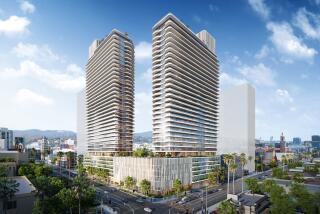Our edifice complex: ‘High-Rise’ and its dystopian architecture hit the big screen
Spoiler alert? When it comes to discussing “High-Rise,” J.G. Ballard’s 1975 novel, there’s no such thing. This is a book whose first sentence famously jumps right to the macabre end of the story, after the residents of a swish, brand-new 40-story tower just outside London have turned on one another and on the building — and as the protagonist sits on his terrace eating his neighbor’s dog.
And so I feel no guilt in telling you a couple of things about the newly released movie version of the story, directed by Ben Wheatley. The first is that the two best-looking people in the film — the suddenly omnipresent actor Tom Hiddleston playing our dog-eating young doctor, and Sienna Miller as a glamorous single mother whose wayward elbows send champagne bottles flying off balcony railings — wind up together in the end, gaunt and grimy but still beautiful, in the sort of concession to genetics that fiction can ignore and around which Hollywood box office is built.
The second thing is that the building wins. The high-rise itself — “this hanging palace,” as Ballard describes it, with its “two thousand inhabitants boxed up into the sky” — proves stoically invulnerable to all of the violence its residents dish out over the course of the story, like a golden retriever sitting perfectly still while a toddler yanks its ears.
Even as its elevator shafts fill with garbage and corpses bob in its swimming pools, the building itself is unflappable. Unlike the infamous Pruitt-Igoe high-rise residential blocks in St. Louis, knocked down three years before Ballard’s novel was published, this tower, on screen as in print, will not play the victim.
REVIEW: ‘High-Rise’ is a towering display of destruction
In that way it makes a sturdy laboratory for testing out some of our contemporary attitudes about the residential high-rise. Is there a building type, a kind of architecture, as packed with as many Freudian, political, environmental or otherwise nightmarish meanings? It’s hard to think of one. Our most powerful current edifice complex these days revolves around the tall building filled with apartments and condominiums.
As we catalogue those meanings, it’s easy enough to figure out where to start: Trump Tower in Manhattan, designed by architect Der Scutt in 1979, the new architectural face of attack-dog populism in American politics, its mirrored-glass façade as slick as the hair on the head of Trump’s middle son, Eric.
Here in Southern California we have the 28-story Palladium Towers in Hollywood, designed by Stanley Saitowitz and — because they are slated to rise next door to a nonprofit run by density hawk and anti-growth town crier Michael Weinstein — poster children for the idea that development in Los Angeles is running wild. (In fact, the production of housing in L.A. has been kept artificially low for more than three decades by zoning and ballot measure alike, in large part to protect the sanctity of single-family neighborhoods; but that’s a story for another day.)
And then there are the so-called pencil towers, new super-tall luxury skyscrapers in London, New York and elsewhere filled with condominiums that are primarily containers for flight capital, havens for fortunes whisked out of Moscow or Shenzhen.
These towers are not full of violence and social unrest, like Ballard’s, but packed mostly with emptiness; their absentee owners may visit once a month, once a year or not at all. All the same, Ballard seems to predict their rise too, imagining near the end of the novel cities where the new towers were not overstuffed but vacant, “a magical domain where these huge buildings were furnished and decorated but never occupied.” There are whole rows of skyscrapers in Dubai that match that description.
Director Wheatley’s version of Ballard’s building, one of five identical towers making up a new high-end enclave on the exurban edge, is meant — like the movie as a whole — to be set not in some vague future but the year of the novel’s publication. This was the period when the oil crisis deepened, Margaret Thatcher began her political ascent, older cities saw wealthy residents flee to the suburbs and the environmental movement gained momentum.
In terms of the story’s ability to leaven its dystopia with irony and even bits of parody, it was also thankfully the period when lapels and pant legs kept widening and Hollywood reliably churned out popcorn disaster movies like “Earthquake” and “The Poseidon Adventure.”
“High-Rise” is not an especially deep or surprising reading of Ballard’s novel — the book’s subtleties keep slipping out of Wheatley’s grasp — but it is consistently glamorous in its filth, very pretty to look at (thanks to production designer Mark Tildesley and graphic design by Michael Eaton and Felicity Hickson) and quietly seeded with visual puns and in-jokes. (Look out for the moments when Hiddleston almost imperceptibly zips up his fly.) It’s amusing to wonder if Jeremy Irons, as Anthony Royal, the tower’s lordly, squash-playing architect, has seen 1974’s “Towering Inferno,” in which his counterpart, Doug Roberts, is played by Paul Newman.
Still, there are signs — at least in terms of straightforward architectural symbolism — that the tower in Wheatley’s movie has something to say about the present moment too.
The cover designs for various print editions of “High-Rise” imagine the building as an anonymous late-modern tower — always with a flat roof, hiding its secrets and violence behind a banal façade. The film version instead leans out dramatically on its top floors, the better to loom over the characters and advertise the fact that the building will prove invincible, the real anti-hero of the story.
That canted profile, architecturally speaking, is contemporary — more MVRDV or Bjarke Ingels than I.M. Pei. It belongs very much to the 21st century.
And so, in the end, does the symbolism of the onscreen tower. Ballard calls the building “a Pandora’s box whose thousand lids were one by one inwardly opening.” If they started opening in 1975, the movie suggests they are still doing so today, with a deep supply of neuroses, architectural and otherwise, still waiting to be let loose.
If you find that hard to believe, get back to me when Trump Tower is the backdrop not just for tweets about taco salad but for news conferences introducing nominees for the United States Supreme Court. Too bad Ballard (who died in 2009) isn’t around to cover the fall campaign.
christopher.hawthorne@latimes.com
More to Read
The biggest entertainment stories
Get our big stories about Hollywood, film, television, music, arts, culture and more right in your inbox as soon as they publish.
You may occasionally receive promotional content from the Los Angeles Times.











